Ansc 221 exam 2 3 Study guides, Class notes & Summaries
Looking for the best study guides, study notes and summaries about Ansc 221 exam 2 3? On this page you'll find 40 study documents about Ansc 221 exam 2 3.
Page 2 out of 40 results
Sort by
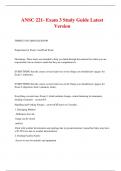
-
ANSC 221- Exam 3 Study Guide Latest Version
- Exam (elaborations) • 30 pages • 2024
- Available in package deal
-
- $12.49
- + learn more
ANSC 221- Exam 3 Study Guide Latest Version THINGS YOU SHOULD KNOW Preparation for Exam 3 and Final Exam Disclaimer: These items are intended to help you think through the material for which you are responsibile, but no claim is made that they are comprehensive. EVERYTHING that the course covered (and was on the 'things you should know' pages) for Exam 1 (nutrients). EVERYTHING that the course covered (and was on the 'things you should know' pages) for Exam 2 (digestion, feed evalua...
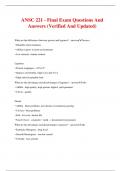
-
ANSC 221 - Final Exam Questions And Answers (Verified And Updated)
- Exam (elaborations) • 8 pages • 2024
- Available in package deal
-
- $11.49
- + learn more
ANSC 221 - Final Exam Questions And Answers (Verified And Updated) What are the differences between grasses and legumes? - answerGrasses: • Palatable when immature • Ability to grow in most environments • Low mineral, vitamin content Legumes: • Protein roughages > 10% CP • Improve soil fertility, high in Ca and Vit A • High yield of palatable feed What are the advantages and disadvantages of legumes? - answerAdv • Alfalfa - high quality, high protein, highest yield po...
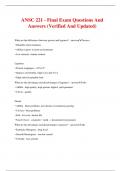
-
ANSC 221 - Final Exam Questions And Answers (Verified And Updated)
- Exam (elaborations) • 8 pages • 2024
- Available in package deal
-
- $11.49
- + learn more
ANSC 221 - Final Exam Questions And Answers (Verified And Updated) What are the differences between grasses and legumes? - answerGrasses: • Palatable when immature • Ability to grow in most environments • Low mineral, vitamin content Legumes: • Protein roughages > 10% CP • Improve soil fertility, high in Ca and Vit A • High yield of palatable feed What are the advantages and disadvantages of legumes? - answerAdv • Alfalfa - high quality, high protein, highest yield po...
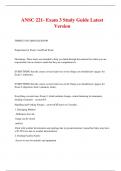
-
ANSC 221- Exam 3 Study Guide Latest Version
- Exam (elaborations) • 30 pages • 2024
- Available in package deal
-
- $11.49
- + learn more
ANSC 221- Exam 3 Study Guide Latest Version THINGS YOU SHOULD KNOW Preparation for Exam 3 and Final Exam Disclaimer: These items are intended to help you think through the material for which you are responsibile, but no claim is made that they are comprehensive. EVERYTHING that the course covered (and was on the 'things you should know' pages) for Exam 1 (nutrients). EVERYTHING that the course covered (and was on the 'things you should know' pages) for Exam 2 (digestion, feed evalua...
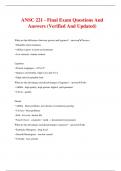
-
ANSC 221 - Final Exam Questions And Answers (Verified And Updated)
- Exam (elaborations) • 8 pages • 2024
- Available in package deal
-
- $11.49
- + learn more
ANSC 221 - Final Exam Questions And Answers (Verified And Updated) What are the differences between grasses and legumes? - answerGrasses: • Palatable when immature • Ability to grow in most environments • Low mineral, vitamin content Legumes: • Protein roughages > 10% CP • Improve soil fertility, high in Ca and Vit A • High yield of palatable feed What are the advantages and disadvantages of legumes? - answerAdv • Alfalfa - high quality, high protein, highest yield po...
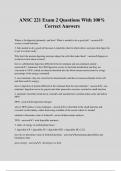
-
ANSC 221 Exam 2 Questions With 100% Correct Answers
- Exam (elaborations) • 10 pages • 2024
- Available in package deal
-
- $12.49
- + learn more
ANSC 221 Exam 2 Questions With 100% Correct Answers Where is fat digested, primarily, and how? What is needed to do a good job? - answer1. occurs in small intestine 2. bile needed to do a good job because it emulsifies that fat which allows enzymes that digest fat to get to it more easily Why don't the protein digesting enzymes digest the cells that make them? - answerpepsin is in inactive form when secreted how is carbohydrate digestion different between ruminant and non-ruminant anima...
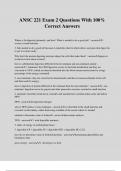
-
ANSC 221 Exam 2 Questions With 100% Correct Answers
- Exam (elaborations) • 10 pages • 2024
- Available in package deal
-
- $12.49
- + learn more
ANSC 221 Exam 2 Questions With 100% Correct Answers Where is fat digested, primarily, and how? What is needed to do a good job? - answer1. occurs in small intestine 2. bile needed to do a good job because it emulsifies that fat which allows enzymes that digest fat to get to it more easily Why don't the protein digesting enzymes digest the cells that make them? - answerpepsin is in inactive form when secreted how is carbohydrate digestion different between ruminant and non-ruminant anima...
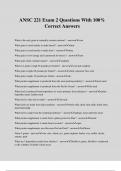
-
ANSC 221 Exam 2 Questions With 100% Correct Answers
- Exam (elaborations) • 6 pages • 2024
- Available in package deal
-
- $11.49
- + learn more
ANSC 221 Exam 2 Questions With 100% Correct Answers What is the only grain to naturally contain carotene? - answercorn What grain is used mainly to make bread? - answerwheat What grain is used mostly to make beer? - answerbarley What grain is low energy and is preferred for horses? - answeroats What grain often contains tannin? - answersorghum What two grains weigh 56 pounds per bushel? - answercorn and sorghum What grain weighs 60 pounds per bushel? - answerwheat, rapeseed, flax seed W...
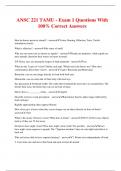
-
ANSC 221 TAMU - Exam 1 Questions With 100% Correct Answers
- Exam (elaborations) • 24 pages • 2024
-
- $14.49
- + learn more
ANSC 221 TAMU - Exam 1 Questions With 100% Correct Answers How do horses perceive stimuli? - answerVision, Hearing, Olfaction, Taste, Tactile stimulation (touch) What is olfaction? - answerthe sense of smell Why are our senses not as intense as equids? - answerPeople are predators, while equids are prey animals, therefore their senses are more in tuned. T/F: Horse eyes are among the largest of land mammals - answerTrue What are the 2 types of vision? Define each type. Which one(s) do hor...
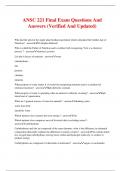
-
ANSC 221 Final Exam Questions And Answers (Verified And Updated)
- Exam (elaborations) • 9 pages • 2024
- Available in package deal
-
- $11.49
- + learn more
ANSC 221 Final Exam Questions And Answers (Verified And Updated) Who had the idea for the single plant feeding experiment which stimulated the Golden Age of Nutrition? - answerDr.Stephen Babcock Who is called the Father of Nutrition and is credited with recognizing "Life is a chemical process"? - answerAntoine Lavoisier List the 6 classes of nutrients - answerwater carbohydrates fats proteins vitamins minerals What property of water makes it so useful for transporting nutrients and...

Did you know that on average a seller on Stuvia earns $82 per month selling study resources? Hmm, hint, hint. Discover all about earning on Stuvia


